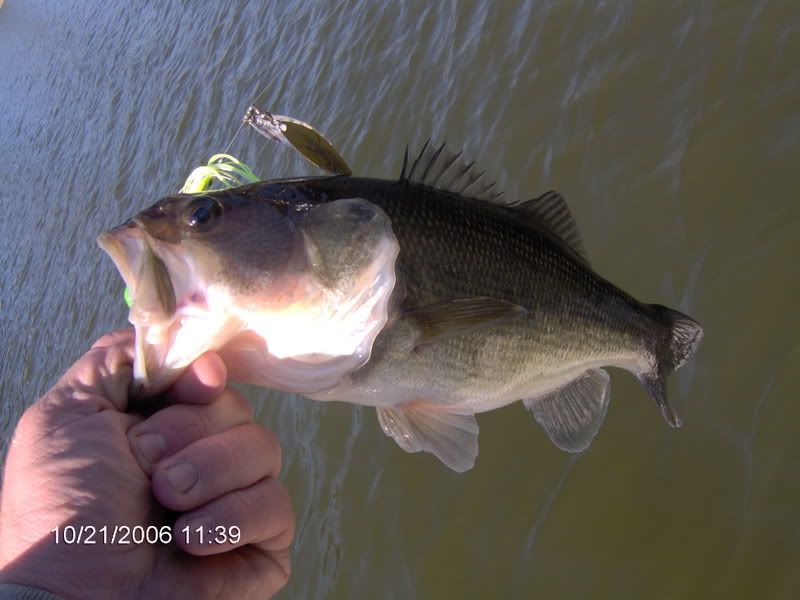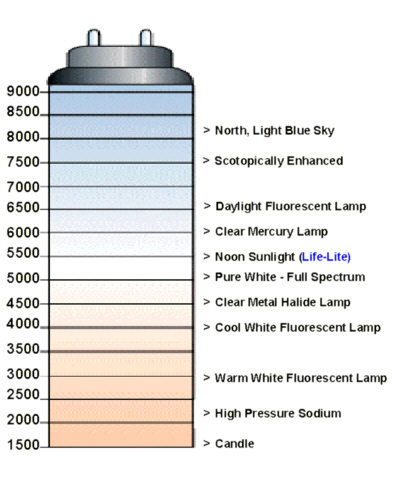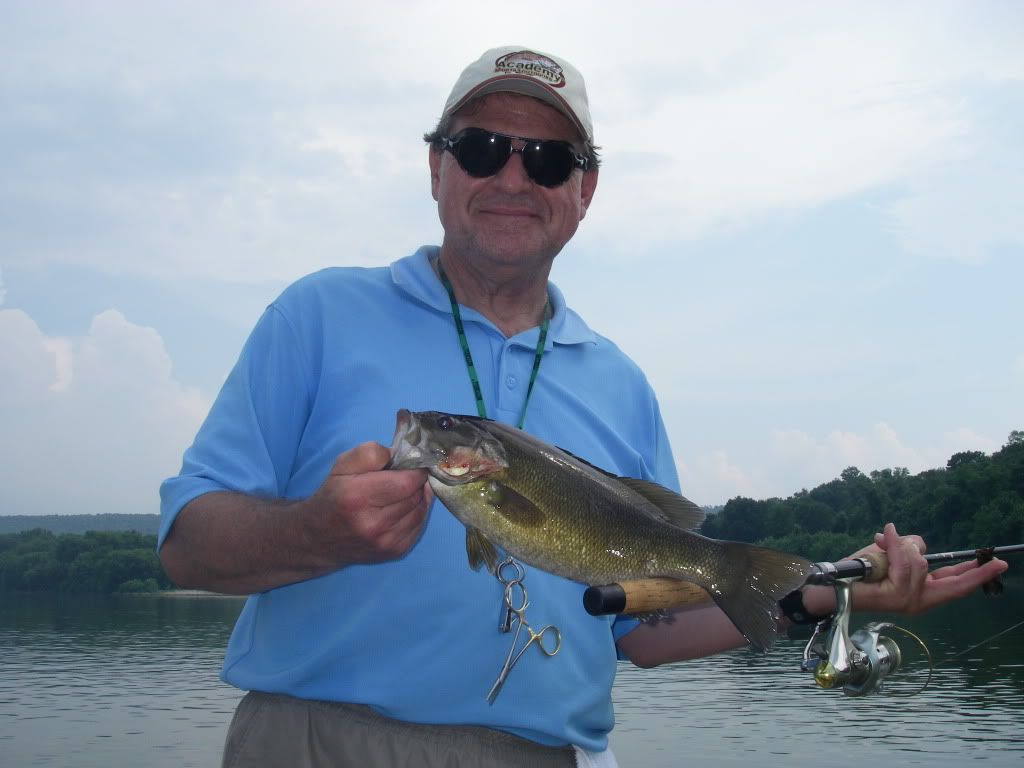|
|
#1 |
|
BassFishin.Com Super Veteran
Join Date: Apr 2005
Location: WA State
Posts: 1,783
|
For the longest time, this has been something I have always wanted to learn. I know that there are a few avid photographers here and would like to ask them to share any tips or techniques with the rest of us "lay" folk to help us take better pics.
So many times, when I take pictures, like close ups of lures or gear, they are never ever captured as I see them with my eyes or when out fishing, how in the world can someone capture decent photos when fishing alone, with no one else to lend a helping hand? I really dislike that the best I can do short of having a tripod (which I don't have yet) is sticking the fish out at arm's length to take a photo. I am now reluctant laying them on the ground or dock, for their health. I imagine that my fellow members wouldn't mind hearing these tips too. So basic questions: How do we decide the best angle(s) from which to take pictures? How do you decide what background to use? How would you best take pictures of fish you catch when you're solo? What tips are there when taking close up of things like fish or gear? Let us operate on assumption that most of us are most likley going to be using the typical automatic click and shoot basic digital cameras on the market today. Thanks ahead of time! -ib Thanks ahead of time.
__________________
ARX "If people concentrated on the really important things in life, there'd be a shortage of fishing poles." Doug Larson (Shimano 2005 Reel Catalog) |
|
|

|
|
|
#2 |
|
BassFishin.Com Premier Elite
|
I like to shoot fish straight on. Taking pictures of fish at angles leads to many more people needing to buy a pink sweater!
 The background depends on where you're at. I think for just plain old pictures of fish, most anything should work ok. If you're taking nice, artsy pictures, then scan your background for things that will distract from the subject and try to remove them. The background depends on where you're at. I think for just plain old pictures of fish, most anything should work ok. If you're taking nice, artsy pictures, then scan your background for things that will distract from the subject and try to remove them.Honestly, without a tripod, I don't know of any better way to take pictures of solo fish than the arms length thing. Many people have problems with up close shots being blurry because the camera won't focus. I used to have the same problem; I'd have to back up and zoom in until it would focus. Then I learned about Macro Mode. Normally represented by a flower on most point and shoot cameras, it allows you to take close up shots of your fishing gear or other smaller subjects. It can be found on the camera mode wheel on top of the camera, it may have it's own button on the face of the camera, or it may be activated via menu. Either way, this is what you want to shoot in to get close up shots of lures, gear, etc. like these. Hope this helps. BB
__________________
As of June 14, 2014 the members of the BF.com forum have moved to basschat.yuku.com! |
|
|

|
|
|
#3 |
|
BassFishin.Com Premier Elite
Join Date: Mar 2009
Location: Southwest IN
Posts: 5,630
|
To add to what Anthony has said:
As far as background goes, stay away from high contrast backgrounds. Your camera, especially a point and shoot type, will analyze and compensate for the light level best when it isn't trying to look at the bright sun right next to the dark brown side of a Smallmouth. This usually means the sun at your back, or slightly to an angle to avoid your own shadow on the fish. Also try to think of composition. I know it's just a fish picture, but any photo can benefit from good composition. Try to shoot the fish against a background that is going to make the fish the STAR of the show. And here is my biggest tip. If you have a good livewell, wait until an hour before dusk to take your fish pics. The diffuse, nearly horizontal light with cooler red overtones just naturally makes for great pics. A good example of all of these techniques is my favorite that I've taken:  Believe it or not, this photo has very little post-processing on it (as evidenced by me not having adjusted the horizon to be perfectly horizontal...I can still do that if I wish).
__________________
Many men go fishing all of their lives without knowing it is not fish they are after. |
|
|

|
|
|
#4 |
|
BassFishin.Com Member
Join Date: May 2010
Posts: 17
|
im realy feelin this shot. its got to be my favorite time of day.any day day not just fishin days. im introgued by the eyes and the blue against the fish. i dont know any thing about photographry and id imagin that accounts for the magic i see in well tuned pictures. bassfeverjohn will probably hit up this thread, id enjoy seein alot of his photos. you read that bfj?post em or send em to me . bassfix7@hotmail.com
|
|
|

|
|
|
#5 |
|
BassFishin.Com Premier Elite
Join Date: Jan 2004
Location: denton nc
Posts: 13,441
|
i take alot of pictures however after an early mistake of showing the bank. i do most of mine at an angle showing nothing but water and fish..
sorry if ya don't like it. i'll make the fish world famus just not my spots..which i worked hard to find in the first place..  zooker
__________________
the godfather.. aml in remission since 7-20-09 |
|
|

|
|
|
#6 |
|
BassFishin.Com Premier Elite
Join Date: Jul 2006
Location: IN
Posts: 8,308
|
Nofear made some great recommendations. Remember that with most photography, less is more. Keep that in mind when background comes into play. Get close to your subject. That holds true for most photographic applications. If you have a vibration reduction tool built into the lens, use it. Take some practice shots of varying distances one handed and see just how closely you can get good focus. One handed you ask? Yes, since you will probably be using one hand to shot when your shooting a fish. Have you thought about taking a shot of the fish while it's still in the water along side the boat? Most point and shoots have a dial that allows you to pick the correct shooting mode for the type of shot you are making. Read your manual and it wil tell you which mode will work best for your pics. You might want to use the closeup mode for shooting pics of your catch, hand held.
|
|
|

|
|
|
#7 |
|
BassFishin.Com Super Veteran
Join Date: Sep 2009
Location: Dallas, TX
Posts: 4,671
|
One thing I've found while trying to take indoor pictures of gear, lighting is critical. When I take indoor pictures of rods i try to create a large light box if you will. I have some big shop lights that I shine into a large white "box".
I have a p&s and my pics aren't all that great, i haven't mastered it either but in my opinion using proper lighting and the macro setting are key for taking indoor gear pictures. |
|
|

|
|
|
#8 |
|
BassFishin.Com Super Veteran
Join Date: Nov 2008
Location: Mena,Arkansas
Posts: 1,327
|
Photography is an artform in and of itself.....I think some folks have a knack for taking good photos all the time, and on occasion great photos, while the rest are clueless, but still manage to snap a good picture now and then....lol
There's already a bunch of great tips already posted so I'll see what I might could add from an "Artists" standpoint. NoFears picture is an excellent example of using lighting, contrast and composition, to produce a great photo. It is very pleasing to the eye and does a great job of drawing you into the photo, making you want to view it longer.......If he hadn't said anything, none of us would've realized the horizon line was slightly askew...and I do mean slightly...lol. He's correct about using fading sunlight to enhance the natural contrasting colors of the fish due to the "warmer" red overtones in the sky. I love taking photos at sunrise or sunset due to these extra colors. Zookers photo on the other hand, does a great job of proving he caught a bass, but its certainly not very pleasing to the eye....Sorry buddy. But at the same time, we all realize he's not trying to take a pretty picture, he's just showin off his catch while trying not to give away his secret spot, by showing any of the background shoreline. It doesn't make for a great photo that you'd want to hang on the livingroom wall, but it accomplished what it was suppose to....it allowed Zooker to share his catch with us, and we're all glad that he does. My photography tips would be these.....Learn your cameras settings and features....play and experiment with them so you'll know what the differences are.....My little point and shoot camera has several settings from Panaramic to Macro, portrait, nighttime, sports, and even an underwater setting among several others. Each will produce a different looking photo under different conditions.....Learn to utilize these settings. Next would be to learn the "Rule of thirds".....it will greatly enhance the way you take photos. This link explains it alot better than I can so check it out. http://digital-photography-school.com/rule-of-thirds You know....taking a quick photo of a bass to share with your buddies is different from taking "Artsy" photos of the lake at sunrise or sunset.....both have their place....but as NoFear showed, even a quick photo of his catch can be done in such a way as to be more then just a quick pic. Now....my one little petpeve with point-n-shoot cameras.....Those butt ugly time/date stamps make me crazy....i've seen more then one nice photo ruined because it had the date and time stamped on it...Some cameras are some what discrete about it, while others plaster large orange lettering across the photo in a font thats WAY to big and ugly.......For God sakes turn that crap off unless your taking junk photos that don't matter.....99.99% of the time, nobody cares what day and time that picture was taken....lol What I do is add the date to the whole batch when I upload them to my computer so I can look back later on, and know when they were taken......But, I personally have never ever wondered, "what time of day did I take that photo"?...WHO CARES!!!....Ok...off my soapbox....lol |
|
|

|
|
|
#9 |
|
BassFishin.Com Super Veteran
Join Date: Apr 2005
Location: WA State
Posts: 1,783
|
Thanks guys! I feel like I just finished the first class of photography 101.
 I am going to apply these for the next few fish I catch.
__________________
ARX "If people concentrated on the really important things in life, there'd be a shortage of fishing poles." Doug Larson (Shimano 2005 Reel Catalog) |
|
|

|
|
|
#10 |
|
BassFishin.Com Premier Elite
Join Date: Mar 2009
Location: Southwest IN
Posts: 5,630
|
By the way, I will go ahead and apologize if my terminology has caused any confusion. It stems from me living in two different worlds: photography and engineering.
Color temperature is defined as what color a "black body" (you can think of a big block of unmeltable steel if it helps) would glow at at a certain temperature, measured in Kelvin. The Kelvin scale is basically nothing more than Centigrade (Celsius) + 273. However, scientists (and engineers?  ) like to sound smart, so they created their own scale (which doesn't use "degrees" when describing it, by the way...it's just "Kelvin"). For a reference, the "absolute zero" you may have heard of is 0 Kelvin, or -273 deg. C. ) like to sound smart, so they created their own scale (which doesn't use "degrees" when describing it, by the way...it's just "Kelvin"). For a reference, the "absolute zero" you may have heard of is 0 Kelvin, or -273 deg. C.From a color temperature standpoint, the yellow-red end of the spectrum is generally less than 2700 Kelvin, or 2700K, for short. This is the color temperature of incandescent bulbs, and the Sun around dusk and dawn (obviously the sun doesn't change color, but the filtering by clouds and dust produce the change). fluorescent lamps, on the other hand, usually range from 3500K up to 6500K (the very blue-ish light you find in critical hospital areas). This is the irony. We tend to call 2700K lighting "warm", but 6500K lighting is "cool" (as in cool white...check your Home Depot). But as an engineer, 6500 Kelvin is obviously waaaaay hotter than 2700 Kelvin. I think the reasoning is thus: Human eyes tend to like "cooler" 4100K-6500K for technical work, since the eye focuses better with the blue content of the light. Think "cold, calculating". However, those same human eyes tend to find "warmer" 2700K and below light more soothing and inviting. Here's a nice chart I found of the types of lighting and their colors.  Probably waaaay more information than you wanted, but I live to serve. 
__________________
Many men go fishing all of their lives without knowing it is not fish they are after. |
|
|

|
|
|
#11 | |
|
BassFishin.Com Premier Elite
|
Quote:
   BB
__________________
As of June 14, 2014 the members of the BF.com forum have moved to basschat.yuku.com! |
|
|
|

|
|
|
#12 |
|
BassFishin.Com Super Veteran
Join Date: May 2006
Location: Accokeek MD
Posts: 3,315
|
I think a good photo is one where there enough light to glisten the fish and a background that highlights the angler. Also the way you hold a fish helps alot.
Bad:  Good:  Capt Mike
__________________
Capt Mike Starrett light tackle guide Potomac River http://www.indianheadcharters.com |
|
|

|
|
|
#13 | |
|
BassFishin.Com Super Veteran
Join Date: Nov 2008
Location: Mena,Arkansas
Posts: 1,327
|
Quote:
 But I now understand why you referred to blue as a "warm" color. because when thinking of colors based on the "black body", blue does occur at higher temperatures, while red occurs at lower "cooler" temperatures. But I now understand why you referred to blue as a "warm" color. because when thinking of colors based on the "black body", blue does occur at higher temperatures, while red occurs at lower "cooler" temperatures. This is the opposite of our cultural associations that colors have taken on, with "red" as "hot", and "blue" as "cold". The traditional associations come from a variety of sources, such as water and ice appearing blue and "cooler", while heated metal and fire are of a reddish hue and appear "warm or hot". However, the redness of these heat sources comes precisely from the fact that red is the coolest of the visible colors, the first color emitted as heat increases. In digital photography,color temperature is sometimes used interchangeably with "white balance", which allow a remapping of color values to simulate variations in ambient color temperature. Most digital cameras and RAW image software provide presets simulating specific ambient values,such as "sunny, cloudy, tungsten, etc." While others allow an exact entry of white balance values in Kelvin. These settings will vary color values along the blue–yellow axis, while some software includes additional controls "sometimes labeled tint" adding the magenta–green axis. Thats based on a typical RBG color wheel if your interested...lol. For the record, all the lighting in my art studio and paintbooth are 6500k bulbs.....This gives me the truest lighting color to paint by......So when i'm done and view the artwork I just airbrushed onto someones motorcycle in the mid day sun, the colors will still look basically the same as they looked inside under artificial lighting. I found out the hard way, that by using lighting in the lower kelvin ranges to paint by, and then viewing that same artwork in the natural sunlight, that my colors changed and didn't look at all as I had intended.....So I changed out all my bulbs for "Daylight" bulbs and that made a world of difference.  Ok....now you have more info than you cared about....hahaha. 
|
|
|
|

|
|
|
#14 |
|
BassFishin.Com Premier Elite
Join Date: Mar 2009
Location: Southwest IN
Posts: 5,630
|
Nice lighting on that Smallie pic, Cap'n Mike.
__________________
Many men go fishing all of their lives without knowing it is not fish they are after. |
|
|

|
 |
|
Disclosure / Disclaimer
Before acting on the content posted, you should know that BassFishin.Com may benefit financially and otherwise from content, advertising, links or otherwise from anything you click on, read, or look at on our website. Click here to read our Disclosure Policy and Disclaimer. |
| Currently Active Users Viewing This Thread: 1 (0 members and 1 guests) | |
|
|